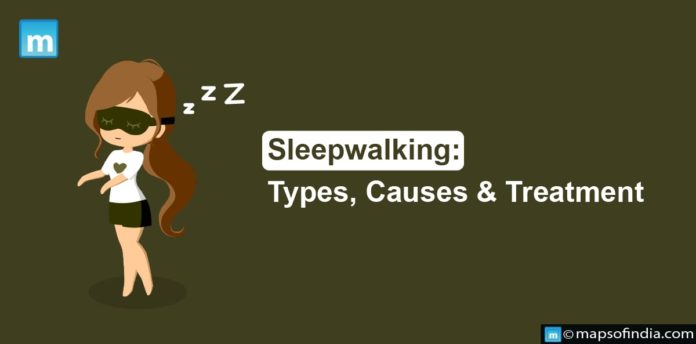Sleepwalking, or somnambulism, is a sleep disorder in which patients move or engage in other activities while sleeping. It is a kind of parasomnia, which is a group of sleep disorders characterized by abnormal activities or experiences while sleeping. Sleepwalking is most prevalent in youngsters, although it can happen to adults as well. Its episodes are usually brief, although they can last up to 30 minutes or longer.
What happens in our body during sleepwalking?
Sleepwalking happens during the deepest stage of sleep, referred to as non-rapid eye movement (NREM) sleep. The brain is less active and the body is more relaxed during NREM sleep. Some regions of the brain, however, such as those that control movement and coordination, remain functioning. This is why sleepwalkers may walk and do other things while sleeping.
Types of sleepwalking
-
Simple Sleepwalking
Simple Sleepwalking is the most prevalent form of sleepwalking. During essential sleepwalking episodes, people usually just walk around. They may also converse, dress, and undress.
-
Complex Sleepwalking
Complex Sleepwalking is a rarer and more severe kind of sleepwalking. complicated sleepwalkers may engage in more complicated activities such as cooking and driving during their episodes.
Causes of Sleepwalking
Sleepwalking’s specific cause is unknown, however it is assumed to be caused by a combination of genetic and environmental factors. Sleepwalking runs in families, thus it is likely that the disorder has a genetic component. A variety of external conditions can also cause sleepwalking episodes, including sleep deprivation, stress, medications, and alcohol. Some medical conditions, such as obstructive sleep apnea and restless legs syndrome, can also increase the risk of sleepwalking.
Impacts of Sleepwalking
Sleepwalking can have several negative impacts on people’s lives, including:
-
Injuries
People who sleepwalk may injure themselves or others during an episode.
-
Embarrassment
Sleepwalking can be embarrassing for the person who is and the people who witness it.
-
Sleep disruption
Sleepwalking episodes can disrupt the sleep of the person who is sleepwalking and the sleep of those who are sleeping with them.
-
Social problems
Sleepwalking can lead to social problems, such as job loss or relationship problems.
Treatment
Although there is no treatment for sleepwalking, there are several things that can be done to minimize the frequency and severity of episodes. Some lifestyle changes that can help to reduce sleepwalking episodes include:
-
Exercise
Exercise can assist improve sleep quality by encouraging deeper sleep. This can reduce your chances of being partially awakened during the night, which is a common cause for sleepwalking.
-
Consistent and Sufficient Sleep Schedule
Maintaining a consistent sleep schedule is crucial for regulating the body’s natural sleep-wake cycle, which can help reduce the risk of sleepwalking. Adults are recommended to get 7-8 hours of sleep per night, while children need 9-12 hours.
-
Stress Management
Sleepwalking is triggered by stress. When stressed, our bodies create hormones that might cause sleep disruption. This can result in interrupted sleep, which increases the likelihood of sleepwalking. Stress management can help to reduce the frequency and severity of sleepwalking.
-
Medication
Medication may be required in some cases to minimize the frequency and severity of sleepwalking episodes. Benzodiazepines and melatonin are two medications often used to treat sleepwalking. Sleepwalking can be an annoying and humiliating condition, but it is vital to remember that it is not a symptom of mental illness or weakness. Most persons who sleepwalk can learn to control their episodes and live regular, healthy lives with proper medication and lifestyle management.




